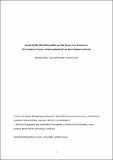Files in this item
Gendered mortality differentials over the rural-urban continuum : the analysis of census linked longitudinal data from England and Wales
Item metadata
| dc.contributor.author | Allan, Rebecca | |
| dc.contributor.author | Williamson, Paul | |
| dc.contributor.author | Kulu, Hill | |
| dc.date.accessioned | 2019-10-20T23:36:12Z | |
| dc.date.available | 2019-10-20T23:36:12Z | |
| dc.date.issued | 2019-01 | |
| dc.identifier | 255993013 | |
| dc.identifier | f0e3ede2-4de9-45d5-9534-096deadda031 | |
| dc.identifier | 85058439885 | |
| dc.identifier | 000456223700008 | |
| dc.identifier.citation | Allan , R , Williamson , P & Kulu , H 2019 , ' Gendered mortality differentials over the rural-urban continuum : the analysis of census linked longitudinal data from England and Wales ' , Social Science and Medicine , vol. 221 , pp. 68-78 . https://doi.org/10.1016/j.socscimed.2018.10.005 | en |
| dc.identifier.issn | 0277-9536 | |
| dc.identifier.other | ORCID: /0000-0001-8808-0719/work/75996989 | |
| dc.identifier.uri | https://hdl.handle.net/10023/18713 | |
| dc.description | The permission of the Office for National Statistics to use the Longitudinal Study is gratefully acknowledged, as is the help provided by staff of the Centre forLongitudinal Study Information and User Support (CeLSIUS). CeLSIUS is supported by the ESRC Census of Population Programme (Award Ref: ES/K000365/1). Rebecca Allan's research was supported by the Economic and Social Research Council through the North West Doctoral Training Centre Social Statistics pathway (PhD project: “Residential Context, Health and Mortality: The Effect of Context, Composition or Selective Migrations?). | en |
| dc.description.abstract | Background: Previous research shows that mortality varies significantly by residential context; however, the nature of this variation is unclear. Some studies report higher mortality levels in urban compared to rural areas, whereas others suggest elevated mortality in rural areas or a complex U-shaped relationship. Further, it also remains unclear the extent to which compositional factors explain urban-rural mortality variation, the extent to which contextual factors play a role and whether and how the patterns vary by gender. This study investigates urban-rural mortality variation in England and Wales and the causes of this variation. Method: The study applies survival analysis to the Office for National Statistics Longitudinal Study. Population aged 20 and older in 2001 are followed 10 years. Results and Conclusions: The analysis shows a clear urban-rural mortality gradient, with the risk of dying increasing with each level of urbanisation. The exceptions are those living in areas adjacent to London who consistently exhibit lower mortality than anticipated. Once the models are adjusted to individuals’ socio-economic characteristics, the variation across the urban-rural continuum reduces substantially, yet the gradient persists suggesting contextual effects. Females are found to be influenced more by their surrounding environment and males by their socio-economic position, although both experience lower mortality in rural compared to urban areas. | |
| dc.format.extent | 1362605 | |
| dc.language.iso | eng | |
| dc.relation.ispartof | Social Science and Medicine | en |
| dc.subject | Mortality | en |
| dc.subject | Health | en |
| dc.subject | Rural | en |
| dc.subject | Survival analysis | en |
| dc.subject | England and Wales | en |
| dc.subject | Urban | en |
| dc.subject | G Geography (General) | en |
| dc.subject | 3rd-DAS | en |
| dc.subject | SDG 11 - Sustainable Cities and Communities | en |
| dc.subject.lcc | G1 | en |
| dc.title | Gendered mortality differentials over the rural-urban continuum : the analysis of census linked longitudinal data from England and Wales | en |
| dc.type | Journal article | en |
| dc.contributor.sponsor | Economic & Social Research Council | en |
| dc.contributor.institution | University of St Andrews. School of Geography & Sustainable Development | en |
| dc.identifier.doi | https://doi.org/10.1016/j.socscimed.2018.10.005 | |
| dc.description.status | Peer reviewed | en |
| dc.date.embargoedUntil | 2019-10-21 | |
| dc.identifier.grantnumber | ES/K000365/1 | en |
This item appears in the following Collection(s)
Items in the St Andrews Research Repository are protected by copyright, with all rights reserved, unless otherwise indicated.

